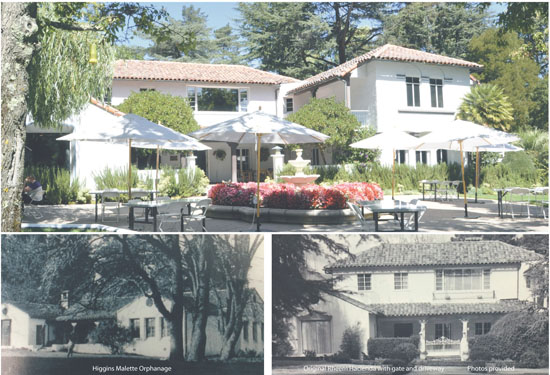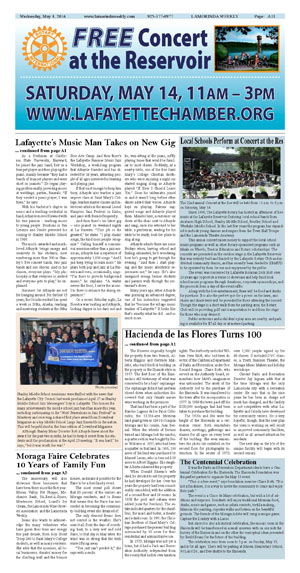|
|
Published May 4th, 2016
|
Hacienda de las Flores Turns 100
|
|
| By Sophie Braccini |
 |
| Moraga's historic Hacienda de las Flores has seen many owners and many changes in its 100 years. A Centennial Celebration is planned for May 15. Top Photo Andy Scheck |
One hundred years ago the first building was erected on the site known today as the Hacienda de las Flores. That piece of land and that building have seen the rise and fall of many local families and enterprises. It is a piece of Moraga history, maybe to be transformed to yet something different for the future.
 The community will celebrate its big anniversary on May 15 at a community celebration, quite befitting for a place that was once known as the Little Hearst Castle.
The community will celebrate its big anniversary on May 15 at a community celebration, quite befitting for a place that was once known as the Little Hearst Castle.
 Elsie Mastick of the Moraga Historical Society remembers the day in the early 1960s when she modeled for a fundraising fashion show around the pool, by special permission of property owner Donald Rheem. The Hacienda de las Flores had been purchased in 1934 by the industrialist for his wife Alice Rheem, who loved the scenic hills and wanted acreage for her horses. In fact, the 20-acre property included stables and racetracks close to what is now El Paraiso Court. Rheem was friends with William Randolph Hearst, and while his Hacienda may not have been on par with Hearst Castle, it was nonetheless known as the San Simeon of the East Bay.
Elsie Mastick of the Moraga Historical Society remembers the day in the early 1960s when she modeled for a fundraising fashion show around the pool, by special permission of property owner Donald Rheem. The Hacienda de las Flores had been purchased in 1934 by the industrialist for his wife Alice Rheem, who loved the scenic hills and wanted acreage for her horses. In fact, the 20-acre property included stables and racetracks close to what is now El Paraiso Court. Rheem was friends with William Randolph Hearst, and while his Hacienda may not have been on par with Hearst Castle, it was nonetheless known as the San Simeon of the East Bay.
 The Rheems originally bought the property from two friends, Alberta Higgins and Gertrude Mallette, who built the first building on the property in the Spanish style in 1917. The first floor of the Hacienda is still testimony of what was conceived to be a boys' orphanage. The orphanage did not last and was closed down when authorities discovered that only female nurses were working on the premises.
The Rheems originally bought the property from two friends, Alberta Higgins and Gertrude Mallette, who built the first building on the property in the Spanish style in 1917. The first floor of the Hacienda is still testimony of what was conceived to be a boys' orphanage. The orphanage did not last and was closed down when authorities discovered that only female nurses were working on the premises.
 That land had been a part of the Rancho Laguna de los Palos Colorados, the 13,316-acre Mexican land grant given in 1841 to Joaquin Moraga and his cousin, Juan Bernal. When the wheels of fortune turned and Moraga lost the rancho, a quarter section was bought by Jesse Williams in 1857, who had been a squatter on that land. In 1906, 160 acres of the land was purchased by Manuel Lucas, who in turn sold 20 acres to Albert Higgins. His daughter Alberta inherited the property.
That land had been a part of the Rancho Laguna de los Palos Colorados, the 13,316-acre Mexican land grant given in 1841 to Joaquin Moraga and his cousin, Juan Bernal. When the wheels of fortune turned and Moraga lost the rancho, a quarter section was bought by Jesse Williams in 1857, who had been a squatter on that land. In 1906, 160 acres of the land was purchased by Manuel Lucas, who in turn sold 20 acres to Albert Higgins. His daughter Alberta inherited the property.
 When Donald Rheem's wife died, he decided to sell the property he had developed for her. Over the years the property had been considerably remodeled, with the addition of a second floor and 18 rooms. In 1938 the pool and cabana were added (now the Pavilion). The estate included quarters for the chauffeur, the maid and butler, a theater and a dark room. In 1961 the Christian Brothers of Saint Mary's College purchased the present building surrounded by 10 acres for their residential and administrative use.
When Donald Rheem's wife died, he decided to sell the property he had developed for her. Over the years the property had been considerably remodeled, with the addition of a second floor and 18 rooms. In 1938 the pool and cabana were added (now the Pavilion). The estate included quarters for the chauffeur, the maid and butler, a theater and a dark room. In 1961 the Christian Brothers of Saint Mary's College purchased the present building surrounded by 10 acres for their residential and administrative use.
 In 1973, Moraga was not yet a town, but it had a Park and Recreation Authority independent from the county that had its own taxation rights. The Authority included William Penn Mott, who had been director of the California Department of Parks and Recreation under Gov. Ronald Reagan. Claire Roth, who served on the Authority board, remembers how Mott's imagination was unbounded. The work of the Authority led to the purchase of the Hacienda. It was transferred to the town after the incorporation in 1977. In 1986 the town paid off the $130,000 mortgage that had been taken to purchase the building.
In 1973, Moraga was not yet a town, but it had a Park and Recreation Authority independent from the county that had its own taxation rights. The Authority included William Penn Mott, who had been director of the California Department of Parks and Recreation under Gov. Ronald Reagan. Claire Roth, who served on the Authority board, remembers how Mott's imagination was unbounded. The work of the Authority led to the purchase of the Hacienda. It was transferred to the town after the incorporation in 1977. In 1986 the town paid off the $130,000 mortgage that had been taken to purchase the building.
 The 1970s and 80s were the height of the Hacienda as a recreation center. Roth remembers dinners, meetings, gatherings and classes for all ages on every level of the building. She even remembers the photo lab installed on the second floor for photography instruction. In the winter of 1975, over 1,000 people signed up for 86 classes. It included DVC classes, a Youth Summer Theater, the Moraga Music Makers and holiday workshops.
The 1970s and 80s were the height of the Hacienda as a recreation center. Roth remembers dinners, meetings, gatherings and classes for all ages on every level of the building. She even remembers the photo lab installed on the second floor for photography instruction. In the winter of 1975, over 1,000 people signed up for 86 classes. It included DVC classes, a Youth Summer Theater, the Moraga Music Makers and holiday workshops.
 Current Parks and Recreation Director Jay Ingram adds that at the time Moraga was the only Lamorinda city with a recreation center. He says that in the nine years he has been in charge not much has changed, and the facility is not competitive with what Lafayette and Orinda have developed for community centers. He is very hopeful, though, that the new plan the town is working on will result in improved community facilities, as well as all around attraction for residents.
Current Parks and Recreation Director Jay Ingram adds that at the time Moraga was the only Lamorinda city with a recreation center. He says that in the nine years he has been in charge not much has changed, and the facility is not competitive with what Lafayette and Orinda have developed for community centers. He is very hopeful, though, that the new plan the town is working on will result in improved community facilities, as well as all around attraction for residents.
 The next step in the life of the unique facility will begin with its second century.
The next step in the life of the unique facility will begin with its second century.


|
 The Centennial Celebration The Centennial Celebration
 It was the Parks and Recreation Department idea to have a Centennial Celebration for the Hacienda. The Hacienda Foundation was the perfect partner to organize the May 15 event. It was the Parks and Recreation Department idea to have a Centennial Celebration for the Hacienda. The Hacienda Foundation was the perfect partner to organize the May 15 event.
 "This is a free event," says foundation member Claire Roth. "It is not a fundraiser, it is a way to invite the community to come and enjoy their park." "This is a free event," says foundation member Claire Roth. "It is not a fundraiser, it is a way to invite the community to come and enjoy their park."
 The event is a Cinco de Mayo celebration, but with a lot of additions and surprises. Residents will enjoy traditional Mexican food, drinks, music and games, such as pinata contests, tortilla making, Mexican tile painting, cupcake walks and loteria on the beautiful grounds. The friends of the Moraga Adobe will bring a unique game, Capture the Donkey with a Lasso. The event is a Cinco de Mayo celebration, but with a lot of additions and surprises. Residents will enjoy traditional Mexican food, drinks, music and games, such as pinata contests, tortilla making, Mexican tile painting, cupcake walks and loteria on the beautiful grounds. The friends of the Moraga Adobe will bring a unique game, Capture the Donkey with a Lasso.
 But since it is also a historical celebration, the mosaic room in the Hacienda will be transformed in a small museum with on one side the history of the Hacienda and on the other the conceptual ideas presented by Gould Evans for the future of the building. But since it is also a historical celebration, the mosaic room in the Hacienda will be transformed in a small museum with on one side the history of the Hacienda and on the other the conceptual ideas presented by Gould Evans for the future of the building.
 The celebration runs from noon to 5 p.m. on Sunday, May 15, and is for all ages. There will be parking at Rheem Elementary School, 90 Laird Dr., and free shuttle to the Hacienda. The celebration runs from noon to 5 p.m. on Sunday, May 15, and is for all ages. There will be parking at Rheem Elementary School, 90 Laird Dr., and free shuttle to the Hacienda.
|
|
|
|
|
|
|
|
| |
|
|
|
|




